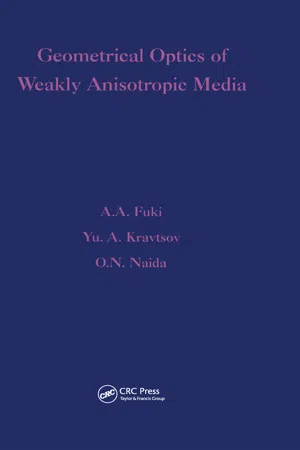1.1 Vector field polarization transformation in weakly anisotropic media
The problem of the propagation of electromagnetic, elastic or other waves in anisotropic media makes up a substantial part of wave physics. The propagation of electromagnetic waves of different bands in a weakly magnetized plasma (laboratory, ionospheric, solar, interstellar), the influence of weak anisotropy of magnetic condensed matter, piezo- and ferromagnets on the transmission of electromagnetic waves, light waves in chiral media and in liquid crystals, polarization phenomena in deformed light guides, propagation of acoustic and seismic waves in weakly anisotropic and/or weakly deformed elastic media, splitting of beams of particles with spin in magnetic fields, that is the list of questions, which is by no means complete, connected with the theory of wave phenomena in weakly anisotropic media.
Melrose and McPhedran (1991), renowned for their contribution to electromagnetic wave theory, define a medium as a weakly anisotropic one if the effect of anisotropy can be treated as a perturbation breaking the degeneracy of the transverse states of polarization. The authors of this book use the the same definition.
Needless to say, the weakness of the anisotropy does not imply the polarization transformation of the electromagnetic field being small. Rather, the contrary holds true: it is precisely media with sufficiently weak anisotropy that are capable of controlling the field polarization structure. To mention a high-school example, let us consider crystal plates capable of converting the linearly polarized light into light with arbitrary elliptical polarization. In particular, a quarter wave plate, i. e., a plate of thickness d in which the difference of optical paths |n 1 – n 2|d between two linearly polarized waves equals λ0/4,
can convert linearly polarized light into circularly polarized light.
Another example of fundamental change of polarization is furnished by the Faraday rotation occurring in natural active media or in media placed in a magnetic field, for example in a magnetized plasma. In either case intrinsic normal waves are polarized circularly. If n# and denote the refractive indices, respectively, for the right and left circular polarizations, the medium slab of thickness d rotates the electromagnetic strength vector through the angle
(Landau and Lifshitz, 1960; Melrose and McPhedran, 1991).
In both examples, even a weak anisotropy,
may be responsible for substantial changes in the polarization of a vector field across a distance on the order of
In the examples considered above, the radical transformation of the polarization structure of the field only occurs at boundaries bounding the homogeneous medium. It is there that the degeneracy of transverse polarization states breaks.
Contrary to that, in a weakly anisotropic media whose parameters vary continuously, mutual transformation of normal waves happens at each point with the resultant polarization being determined by the magnitude of anisotropy and the rate at which the medium parameters vary.
The main feature of inhomogeneous weakly anisotropic media is their capability of substantially transforming the polarization structure of vector fields. Polarization transformation in weakly anisotropic regions of an inhomogeneous medium owes its existence to a strong interconversion of normal waves: it is in these regions that the polarization degeneracy smoothly arises or lifts. In essence, in a weakly anisotropic medium, the polarization structure of a wave field undergoes a drastic transformation: while in anisotropic medium the electromagnetic field is represented by a superposition of two normal waves, each characterized by a definite, intrinsic polarization, in an isotropic medium transverse magnetic waves are polarization-degenerate and the state of their polarization is not defined.
On entering an anisotropic medium, a transverse electromagnetic wave ceases to be polarizationally degenerate and experiences a substantial change of polarization. The conversion (reconstruction, “pere- stroyka”) of the polarization structure occurs in a weakly anisotropic layer that matches isotropic and anisotropic media, as shown in Figure 1.1). The final result of the polarization conversion (“polarization per- estroyka”) is the transformation of the polarization-degenerate transverse wave into a superposition of independent normal waves.
The polarization transformation of waves in an anisotropic medium is a physical problem of general character, which is important both theoretically and practically. This book is dedicated to its analysis.
